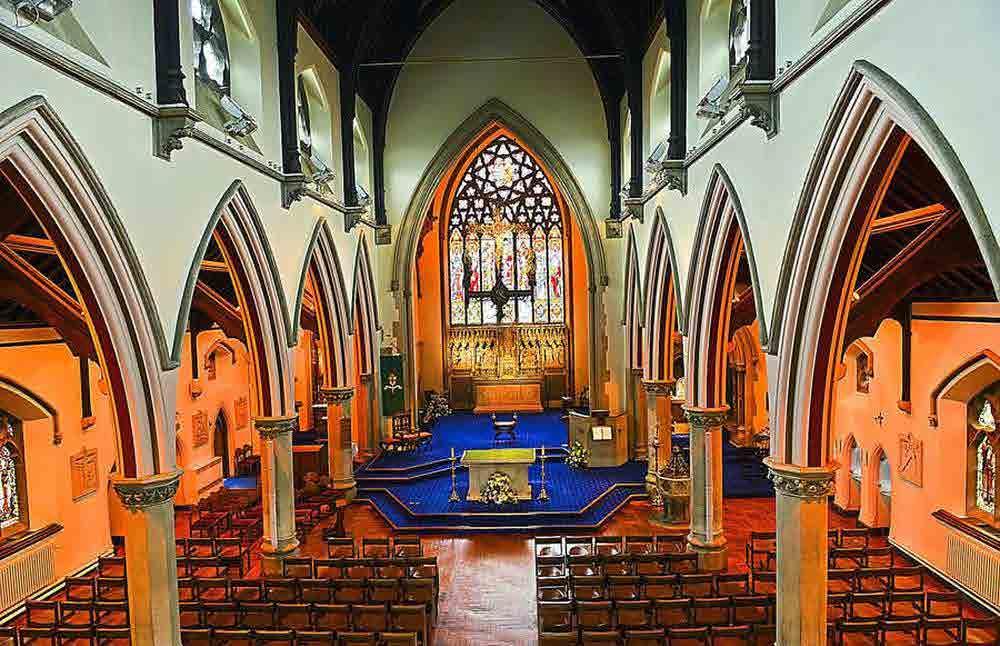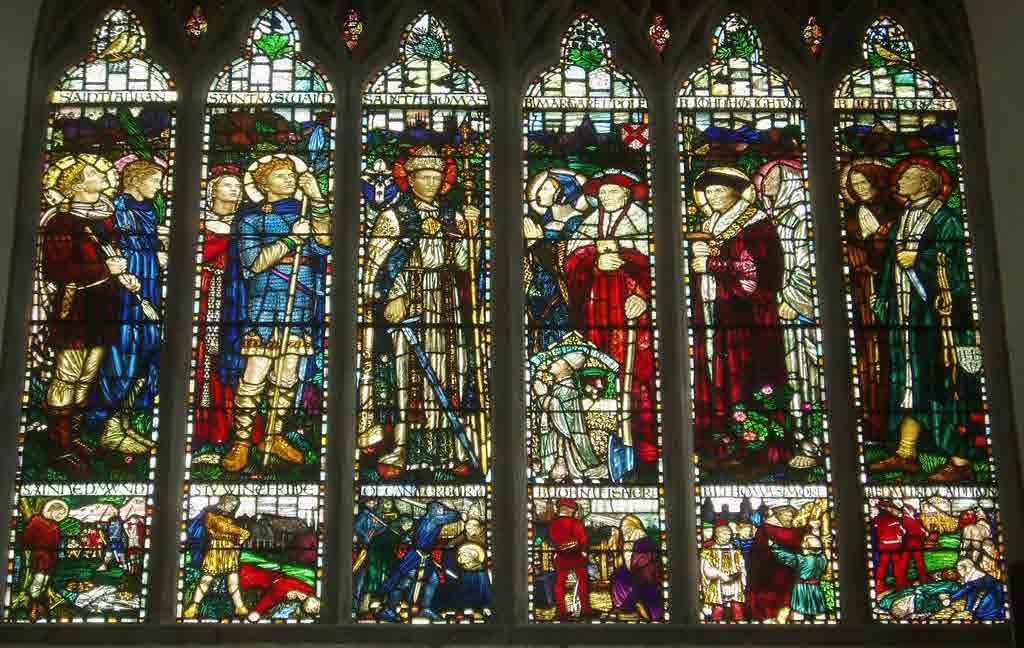
6 minute read
The Cathedral Church of Our Lady Help of Christians and St Peter of Alacantara
Paul Waddington looks at the history of Shrewsbury’s cathedral, and explains how such a small building became a cathedral
Shrewsbury got its first post-Reformation Catholic chapel in 1776. Situated in the street known as Town Walls, it was originally a simple building in the style that we now associate with Nonconformist chapels. Extensions of 1826 and 1840 gave it a classical facade, and increased the seating capacity to 300. But by the late 1840s, the Catholic population of Shrewsbury had grown to the extent that a larger building was required. With this in mind land was purchased further along Town Walls, which eventually became the site of Shrewsbury Cathedral, but not before several changes of plan.
When the Catholic Hierarchy of England and Wales was re-established in 1850, it was decided that the counties of Shropshire and Cheshire should form a diocese to be named Shrewsbury, largely in deference to John Talbot, the 16th Earl of Shrewsbury, who had funded the building of several churches, especially around his estate of Alton Towers in Staffordshire. A new cathedral was necessary as there was no existing church in the two counties of sufficient

The interior has much to admire
size or dignity to fill the role. The siting of the new building became the subject of much debate. As a temporary measure, A.W.N. Pugin’s newly completed Church of St Alban in Macclesfield was selected to serve as a pro-cathedral.
Birkenhead, Chester or Shrewsbury?
Because of the concentration of Catholics in the Wirral, Birkenhead was initially the favoured location; but, the Earl’s offer to pay for a cathedral if it were built in Shrewsbury swayed opinion in favour of that town. A.W.N. Pugin would naturally be the architect. However, in 1851, Bishop Brown surprised everybody by purchasing a Georgian house in Chester with adjacent land, with the intention of building the cathedral there. Objections to this proposal, particularly from the Earl and his architect friend were sufficiently strong for the bishop to back down.

The exterior: the cathedral is constructed of sandstone, and has a five-bay nave with side aisles
At this point fate intervened, because both the Earl and A.W.N. Pugin died before work could be started. Bertram Talbot, the nineteen-year-old nephew of John, became 17th Earl of Shrewsbury, and despite his young age, renewed the family commitment to fund the Shrewsbury project. It fell to Edward Welby Pugin, also aged nineteen, the eldest son of A.W.N. Pugin, to draw up plans for a cathedral to be built on the site purchased some years previously. This was his very first architectural commission, and he designed a cathedral, said to be capable of seating one thousand, with a tower and spire having a combined height of 227ft. It would certainly have been a prominent landmark on the Shrewsbury horizon.
Again fate intervened, because, after construction had started in 1853, it was discovered that the soil conditions on the hillside would not support a building of that size. The tower and spire had to be deleted from the scheme, and plans were scaled down to such an extent, that the building was no longer thought sufficiently dignified to serve as a cathedral.

The West Window, English Martyrs by Margaret Rope
Birkenhead was in need of a large church at the time; and, in another change of plan, it was decided to build the new cathedral there. The Earl, presumably with some disappointment, agreed to fund the new project in addition to the Shrewsbury church. Edward Pugin drew up plans for Birkenhead, which included a tower with spire similar to that which had been proposed at Shrewsbury, but an unexpected turn of events meant that Birkenhead never got a cathedral.
It seems that Rome objected to this latest scheme on the grounds that a cathedral in Birkenhead would be too close to the one proposed just across the river in Liverpool. Edward Pugin’s plans for Birkenhead were eventually executed as the church of Our Lady, which opened in 1862 and exists to this day, although the tower and spire were never built. In yet another change of plan, it was decided that Shrewsbury’s much reduced church would become the cathedral. It eventually opened in October 1856, two months after the tragically early death of Bertram, aged only twenty-three.
The cathedral is constructed of sandstone, and has a five-bay nave with side aisles. Over the western gable there is a bellcote. Due to its hillside location, it is approached by steps from the road. Although unspectacular on the outside, there is much to be admired internally. The chancel has a fine seven light window with intricate tracery and stained glass by the Hardman company dating from 1862. Beneath it, E.W. Pugin’s Caen stone High Altar and reredos, although not currently used, have survived the drastic reordering carried out in the 1980s. Also in the chancel are sedilia built into the south wall in a similar manner to A.W.N. Pugin’s sedilia at St Giles’ Church in Cheadle.
Much of the internal decoration dates from 1885, and is largely the work of J.A. Pippett, chief designer of the Hardman company. He designed much of the stained glass, remodelled the side chapel in the northern aisle, and adorned extensive areas with wall paintings and other decorative schemes. Further work was undertaken fifteen years later by Pippet’s son, Gabriel. Unfortunately, much of this work was covered by indiscriminate whitewashing in the 1950s. The spectacular hanging rood with the figures of Our Lady and St John, which replaced a simpler one by Edward Pugin, dates from this period. Pugin originally proposed a full rood screen, but this was vetoed by 17th Earl, who clearly believed that there should be an uninterrupted view of the sanctuary.
A Much Underrated Architect
Further improvements were made in 1901, when Edmund Kirby added a chapel dedicated to St Winefride to the southern aisle. This is an imposing polygonal structure with a complicated vaulted roof supported by many delicate columns. It is arguably the most impressive feature of the cathedral. Edmund Kirby had been educated at Oscott College and later articled to Edward Pugin, before practising on his own. With such a background, it is not surprising that the chapel blends in perfectly. If his work in Shrewsbury is anything to go by, he is a much-underrated architect.
Shrewsbury Cathedral also has a quantity of twentieth century stained glass, some of it replacing windows designed by the Hardman company, which were transferred to the nearby convent. Most of this, including the five light West Window depicting English Martyrs, is the work of Margaret Agnes Rope, a native of Shrewsbury and exponent of the Arts and Crafts tradition. Margaret Rope, a convert to Catholicism later became a Carmelite nun.
Blue Carpet
In a disastrous reordering scheme executed in 1984, the communion rail was removed, the sanctuary floor raised, and a platform installed to extend the sanctuary into the nave, where a forward altar and ugly ambo were installed. All was covered by a most inappropriate blue carpet, which is currently the dominant feature. The encroachment into the nave substantially reduced the seating capacity which was already extremely limited. The choir stalls were removed, as were all the benches, which were replaced by modern style individual © A.M.Thomson seats. More sensitive work was carried out in 2014 when the entrance, which was previously directly off the street, was made more convenient with new steps and railings.
The Cathedral Church of Our Lady Help of Christians and St Peter of Alacantara is a Grade II* Listed Building. Despite the damage done by reordering, there are still many excellent original features, and the Cathedral is well worth a visit. There are plans afoot to restore much of the damage done in the 1980s, including the removal of the blue carpet, which should reveal the original Minton tiles of the sanctuary. It remains to be seen how much of Pippet’s decorative work can be restored.
In 2018, the Institute of Christ the King Sovereign Priest arrived in Shrewsbury. One of their priests is resident at the Church of St Winefride, which is part of the Cathedral parish, and where a Sunday Mass is offered in the Extraordinary Form. They also offer a daily EF Mass in the Cathedral.










